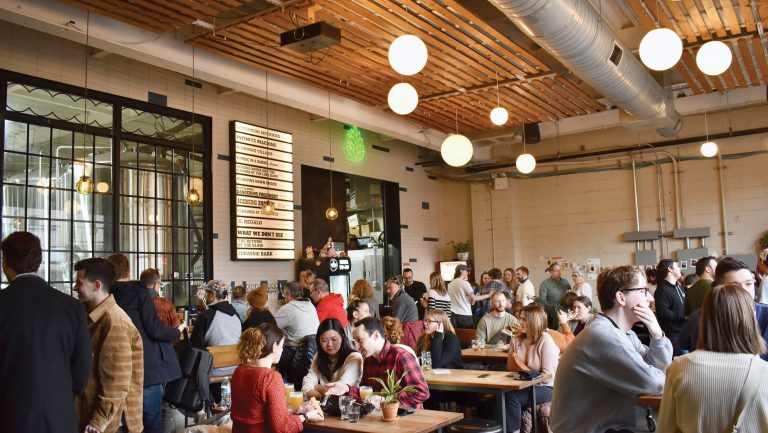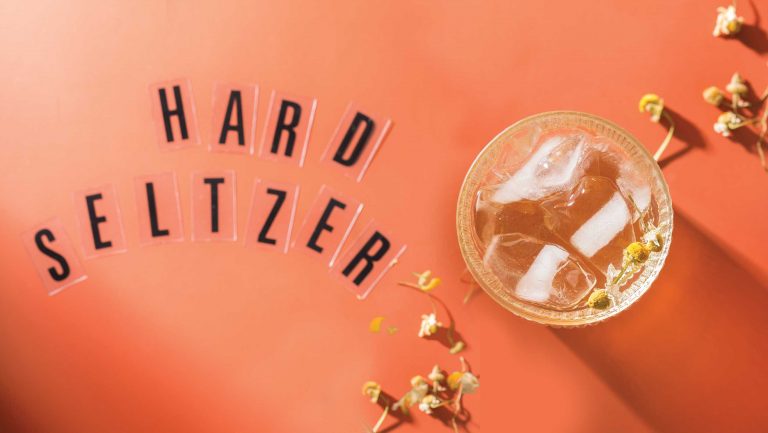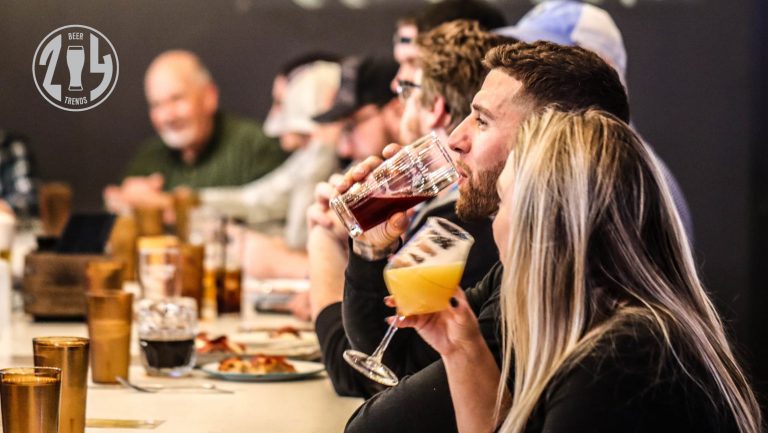Last year, a landlord for Denver’s metal-loving TRVE Brewing delivered some expensive bad news. Rent was increasing at TRVE’s production facility, nicknamed the Acid Temple, where the brewery began making IPAs, lagers, and mixed-culture beers in 2014.
Stomaching a rent hike was unappetizing. Over the last decade, operating a labor-intensive brewing system in an aging industrial building had grown tougher, sending TRVE on a fruitless search for suitable space. “Nothing suited our needs,” says Nick Nunns, the founder and CEO.
At a beer event last fall, Nunns discussed the predicament with Brandon Capps, the founder of New Image Brewing, which opened a larger production facility in Wheat Ridge, Colorado, in 2022. New Image’s excess capacity could help TRVE produce beer at scale, no need for additional infrastructure. “Every brewery doesn’t need to have its own system,” says Erin Nunns, TRVE’s co-owner and COO.

Don’t miss the latest drinks industry news and insights. Sign up for our award-winning newsletters and get insider intel, resources, and trends delivered to your inbox every week.
This February, TRVE closed the Acid Temple and relocated production to New Image, a move meant to safeguard TRVE’s business operations for the foreseeable future. “Craft beer isn’t growing like it once was, but it’s growing up,” says Capps. After several decades of steady and sometimes stratospheric growth, the craft beer industry has seen declining sales for the past few years, thanks to an overcrowded market, changing drinking behaviors, and competition from canned cocktails, spirits, and other new beverage categories.
“Double-digit growth papered over many business issues,” says Bart Watson, the chief economist for the Brewers Association. Last year, off-premise craft beer sales declined nearly one percent while volumes dropped 4.4 percent according to Circana, a Chicago-based market research firm. And the drumbeat of notable brewery closures sounds louder each week, with North Carolina’s New Anthem Beer Project and Necromancer Brewing in Pittsburgh, Pennsylvania, shuttering this winter.
To better navigate today’s choppy economic waters, breweries are reevaluating production and product mix to stay afloat and better serve a reduced, yet still thirsty consumer base. Creating targeted portfolios through SKU rationalization and recalibrating focus on core ranges, in addition to exploring hard tea and THC beverages, can rightsize operations for the craft brewing industry’s new economic reality.
Beer Drinkers Are Becoming Less Promiscuous
Prior to the pandemic, craft breweries could package any hazy IPA and expect customers to purchase every four-pack. Novelty drove consumer demand.
“It was almost like a treasure hunt,” says Dan Scheie, a utility electrician and craft beer aficionado from Yonkers, New York. But an onslaught of weekly releases can cause customer fatigue. When the pandemic paused taproom visits, Scheie began buying the same trusted beers sold nearby.
“Funny enough, a world-class beer like Sip of Sunshine from Lawson’s [Finest Liquids] was readily available at the gas station down the hill from my house,” he says.

Reliability and availability are becoming important metrics, especially as customers grow more hesitant to spend $20 on an unknown four-pack. “We’ve seen a shift back into a safety net,” says Matt Drummond, the client solutions manager for market research firm NIQ. “People want to know what they’re going to get when they buy a beer.”
At Array Bottle Shop, in Portland, Oregon, beer buyer and co-owner Stephen Braigen only offers eight taps (seven beer, one cider) and a tightly curated selection of packaged beer and cider. “More drinkers seem to be going back to things that they enjoyed and want to have again.”
Reining in Releases Is Key for Distribution
Cutting down on beer releases seemingly contradicts the creative, anything-goes ethos that fueled craft brewing’s 2000s boom. Dream it, brew it, sell a ton of it. But these days, just because a brewery can brew something doesn’t mean it should.
“The marketplace has pretty unanimously decided that it doesn’t need more variety,” says Zack Kinney, a founder of Kings County Brewers Collective (KCBC) in Brooklyn. KCBC cut around 20 percent of its SKUs last year and will eliminate a similar amount this year. “Not all ideas and experimentation are worthy of a long life,” Kinney says.
KCBC produces experimental beers for its taproom audience while prioritizing five core beers for distribution, including Infinite Machine pilsner and Superhero Sidekicks IPA. Bulk purchasing boosts the bottom line. “Economies of scale are much more available to us when we’re committing to core recipes,” Kinney says, adding that KCBC is ready to package beers in different formats, such as 12-packs, should retailers request it.
Distributors are helping steer this less-is-more approach. During its annual business-planning meetings, Vacationland Distributors, which covers New Hampshire and Maine, counsels breweries on focusing on three to five stable, always available SKUs that can be sold at chain accounts like grocery stores.
“We’re preaching back to basics,” says co-owner and vice president John Squadrito. Part of this is a reaction to slowing sales of one-off and collaboration beers. “People want those core SKUs to rely on, whether it’s on tap or on store shelves.”
Vacationland also works closely with breweries on retail pricing, starting first with a brand’s ideal market price and working backward to figure out margins. “I’d rather price the beer right to the consumer and have traction and longevity with a brand,” Squadrito says.
It’s also imperative for distributors to streamline and simplify decisions for beer buyers overwhelmed by all that choice. Sarene Craft Beer Distributors operates in five states, from Ohio to New York, and distributes more than 100 brands, including lager experts Schilling Beer. Instead of trying to sell dozens of beers from a brewery, Sarene highlights a handful of core beers that might be complemented by one or two rotating releases each month.
“You’re keeping people who want to have that shiny new toy happy while still being able to grow your brand through these main money movers,” says Kevin King, the brand development manager.
Focused Breweries Can Still Grow
Ten years ago in craft beer, breweries could fling any sales dart at a dartboard—beer style, business model, branding—and “hit a bull’s-eye,” Watson says. “Now you’ve really got to aim.”
Breweries and brands with clear, consistent messages and a focus on quality products are outperforming the industry at large. Fiddlehead Brewing in Shelburne, Vermont, grew 22 percent last year on the backs of its flagship IPA and other hop-forward beers that are delivered, stored, and sold cold. “It’s an important element to our success story,” president and owner Matt Cohen said in a press release.
The craft beer industry’s biggest growth driver is New Belgium Brewing’s Voodoo Ranger family of IPAs. Last year, they accounted for six of Circana’s top 30 craft beer brands, led by Voodoo Ranger Imperial IPA (number two) and fruity Voodoo Ranger Juice Force (number three).

In particular, the expanding Force line, including the punch-like Fruit Force and Tropic Force, is finding fans that “love high ABV paired with bold flavor,” says Michelle Robertson, New Belgium Brewing’s senior brand manager for Voodoo Ranger. “We’re not just trying to speak to the craft beer drinker.”
While New Belgium is finding traction in convenience stores with single-serving 19.2-ounce cans, there’s only so much shelf space for another IPA. “We have to keep a close eye on not over-innovating,” Robertson says. Last year, New Belgium released the Voodoo Ranger Hardcharged Tea, seeking white space in its portfolio instead of crowding another beer SKU into a cooler.
Embracing a different buzz can help a brewery branch out. As laws evolve, breweries are finding greener pastures with mood-altering THC drinks. In February, Hopewell Brewing in Chicago released the sparkling Choom, a lemon-lime beverage infused with hemp-derived THC—legal, thanks to the federal government’s 2018 Farm Bill.
“Choom is currently our top seller in the taproom to go,” says cofounder Samantha Lee, adding that four-packs cost between $15 and $20 depending on potency. “It’s not eating into beer sales. The hope is that it’s another area of growth.”
There are no easy fixes, or magical hop blends, that will revert craft beer to its mid-aughts sales peaks. Making quality beer used to be a differentiator; now it’s table stakes. Surviving and thriving in today’s busy market requires breweries to excel at brewing and Excel spreadsheets, planning futures beyond another batch of beer.
By partnering with New Image, TRVE can adjust batch sizes to meet still-increasing wholesale demand for its beer, helping it focus on expansions. In March, TRVE opened a new location in Asheville, North Carolina, where it will brew for the local market, and plans to open a second Denver taproom this year. The goal is to build a sustainable business model, anchored in taproom experiences, that will sustain the brewery’s ownership until retirement.
As Nick Nunns says, “Beer is such a community-driven and celebratory beverage it’s easy to forget that, when you strip it down, it is a business.”

Dispatch
Sign up for our award-winning newsletter
Don’t miss the latest drinks industry news and insights—delivered to your inbox every week.
Contributing editor Joshua M. Bernstein is a beer, spirits, food, and travel journalist, as well as an occasional tour guide, event producer, and industry consultant. He writes for the New York Times, Men’s Journal, New York magazine, Wine Enthusiast, and Imbibe, where he’s a contributing editor in charge of beer coverage. Bernstein is also the author of five books: Brewed Awakening, The Complete Beer Course, Complete IPA, Homebrew World, and Drink Better Beer.






